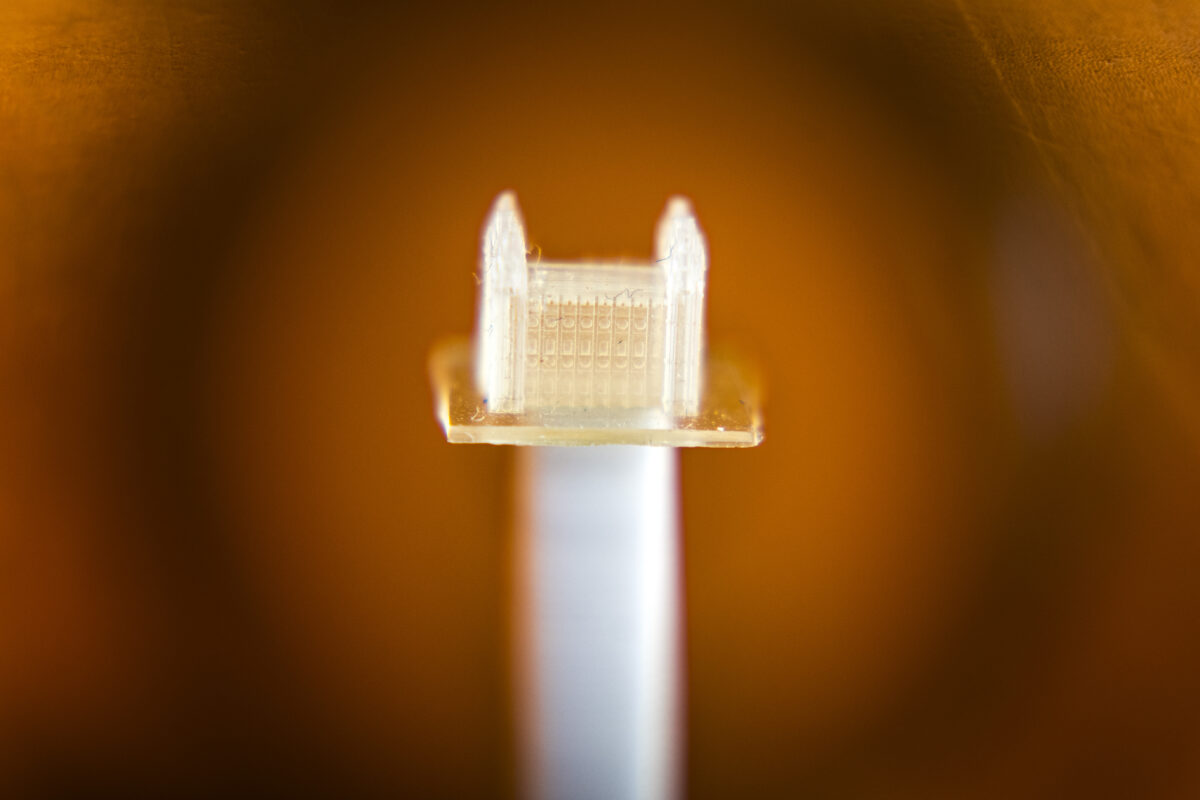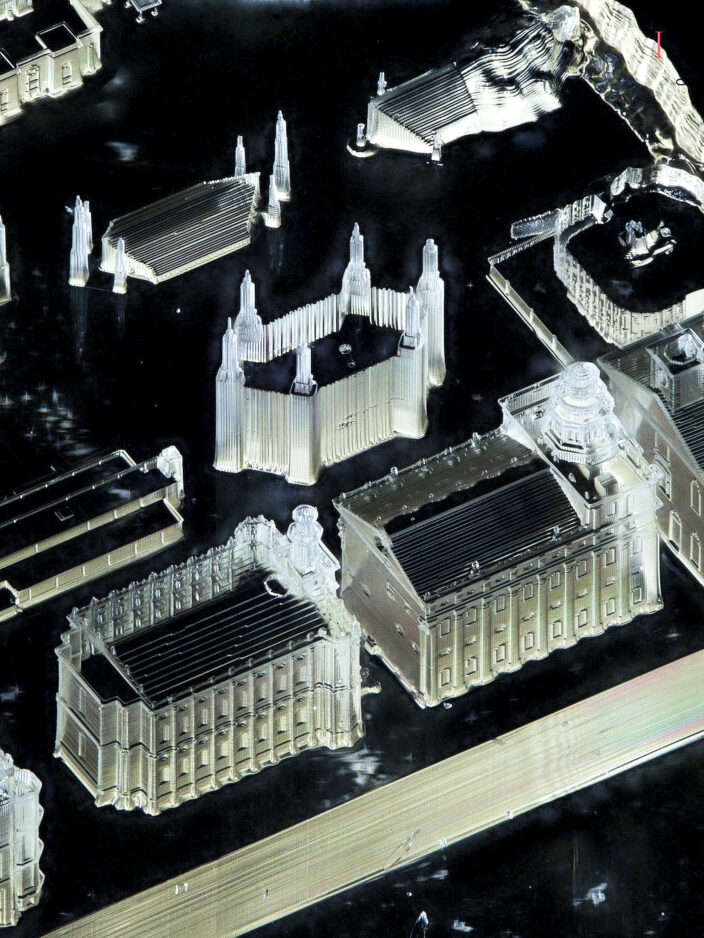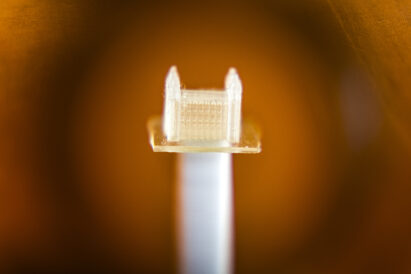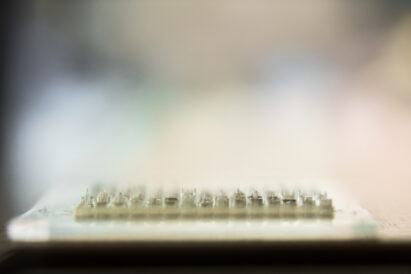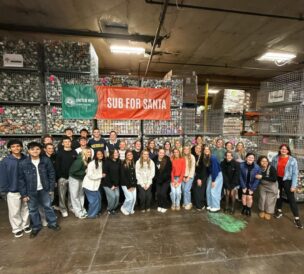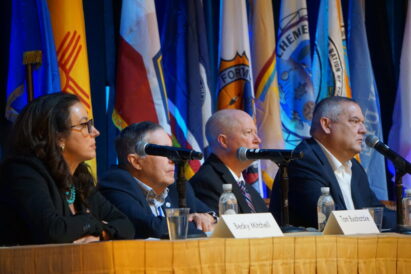150 temples for 150 years: BYU engineers create 3D mini Latter-day Saint temples to celebrate school’s sesquicentennial year
- A mini Salt Lake Temple replica created by a 3D printer at Brigham Young University is shown.
- Mini temple replicas created by a 3D printer at Brigham Young University are shown.
- Mini temple replicas created by a 3D printer at Brigham Young University are shown.
- Mini temple replicas created by a 3D printer at Brigham Young University are shown.
Tasked with honoring the school’s 150th anniversary, Brigham Young University engineers combined the school’s values of innovation and faith to produce a perfectly BYU-esque project.
Using the engineering department’s high-resolution 3D printer, electrical engineering professor Greg Nordin and sophomore Callum Galloway created miniature versions of 150 temples of The Church of Jesus Christ of Latter-day Saints.
Each built upon a 12-by-19 millimeter microchip — smaller than a grain of rice — the temples have unique floor plans, fitted with windows, doorways and other designs that require a microscope to see.
“BYU is a place of learning, and so are the temples, but in different ways that are complementary,” Galloway said. “And so we had this iconic thing that was very symbolic, and then we took that and kept it recognizable at a small scale. It was a very unique kind of thing that you could only really do at BYU.”
Nordin said the idea was suggested by BYU engineering professor Aaron Hawkins, who knew the capability of the department’s 3D printer.
It was up to Galloway, a computer engineering major, to determine which temples to recreate out of 200-plus options.
He relied on free 3D computer temple models uploaded to thingiverse.com. While he was going through the temple models chronologically, he began to notice that many of them have the same floor plan — which wouldn’t work well for 3D printing.
“The temples are very different — different stained glass, different materials; but when you just have the 3D model of it, they don’t look too different,” Galloway said. “So I went chronologically and found all the temples that had very distinct floor plans, and that was how they were chosen.”
Selected temples included the Salt Lake Temple, Provo City Center Temple, and Galloway’s personal favorite, the Richmond Virginia Temple.
“My wife and I both served in that mission when it was dedicated and we participated in the open house,” he said. “I love the combination of pillars, spires and the Jefferson dome.”
After choosing the temples came the hard part: Printing them.
BYU Engineering’s 3D printer is designed to take a biomedical laboratory or major instrument and shrink it down to a small chip, and have the chip perform biomedical assays, according to Nordin.
Such a device requires the 3D printer to create “negative features,” or areas where there isn’t any material, making space for fluid that will be biomedically analyzed, Nordin said. The temple project, however, required a positive geometric feature.
“It’s what is there that matters as opposed to what’s not there,” Nordin said.
That’s where the 3D printer showed off its optimization, switching from negative to positive geometries, and 3D computer models of the temples were created with carbon-based material through photopolymerization.
“Callum basically took our capabilities and reoriented them toward these positive feature geometries, namely the temples, and found that it works great,” Nordin said.
“And it was almost just incidental that the technology we’ve developed for such fine processes was able to tackle the problem — no issue,” added Galloway.
Now that they’re created, the question is how the temples will be incorporated into the 150th anniversary. The challenge, Nordin said, is how the public will be able to see the temples because they’re so tiny.
One solution is to place a movable microscope for people to walk up to at a display, peer into and be able to see all 150 temples from various vantage points.
It’s a unique problem for a unique project that the engineers are proud of.
Nordin said the mini temples reflect BYU’s emphasis on “experiential learning” and how students go beyond the classroom and put things into practice in the lab.
“I just think that’s so powerful in terms of getting a high-quality education for the students, and I’m always amazed at what the students produce,” he said. “We just have fantastic students, and it’s just so fun to turn them loose and see what their creativity develops.”
Galloway was just grateful he could place his unique stamp on the school’s 150th anniversary.
“It felt like a very special opportunity,” Galloway said. “It’s not every day you have a sesquicentennial. And so being in the right place, the right time, with the right talents felt pretty evident and very much a blessing to me.”

